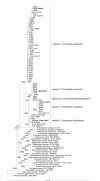The taxonomy of Enterobacter sakazakii: proposal of a new genus Cronobacter gen. nov. and descriptions of Cronobacter sakazakii comb. nov. Cronobacter sakazakii subsp. sakazakii, comb. nov., Cronobacter sakazakii subsp. malonaticus subsp. nov., Cronobacter turicensis sp. nov., Cronobacter muytjensii sp. nov., Cronobacter dublinensis sp. nov. and Cronobacter genomospecies 1
- PMID: 17439656
- PMCID: PMC1868726
- DOI: 10.1186/1471-2148-7-64
The taxonomy of Enterobacter sakazakii: proposal of a new genus Cronobacter gen. nov. and descriptions of Cronobacter sakazakii comb. nov. Cronobacter sakazakii subsp. sakazakii, comb. nov., Cronobacter sakazakii subsp. malonaticus subsp. nov., Cronobacter turicensis sp. nov., Cronobacter muytjensii sp. nov., Cronobacter dublinensis sp. nov. and Cronobacter genomospecies 1
Abstract
Background: Enterobacter sakazakii is an opportunistic pathogen that can cause infections such as necrotizing enterocolitis, bacteraemia, meningitis and brain abscess/lesions. When the species was defined in 1980, 15 biogroups were described and it was suggested that these could represent multiple species. In this study the taxonomic relationship of strains described as E. sakazakii was further investigated.
Results: Strains identified as E. sakazakii were divided into separate groups on the basis of f-AFLP fingerprints, ribopatterns and full-length 16S rRNA gene sequences. DNA-DNA hybridizations revealed five genomospecies. The phenotypic profiles of the genomospecies were determined and biochemical markers identified.
Conclusion: This study clarifies the taxonomy of E. sakazakii and proposes a reclassification of these organisms.
Figures



References
-
- Farmer JJ, III, Asbury MA, Hickman FW, Brenner DJ, the Enterobacteriaceae Study Group (USA) Enterobacter sakazakii: a new species of "Enterobacteriaceae" isolated from clinical specimens. Int J Syst Bacteriol. 1980;30:569–584.
-
- Stackebrandt E, Frederiksen W, Garrity GM, Grimont PAD, Kämpfer P, Maiden MCJ, Nesme X, Rosselló-Mora R, Swings J, Trüper HG, Vauterin L, Wards AC, Whitman WB. Report of the ad hoc committee for the re-evaluation of the species definition in bacteriology. Int J System Evol Microbiol. 2002;52:1043–1047. doi: 10.1099/ijs.0.02360-0. - DOI - PubMed
Publication types
MeSH terms
Substances
Associated data
- Actions
- Actions
- Actions
- Actions
- Actions
- Actions
- Actions
- Actions
- Actions
- Actions
- Actions
- Actions
- Actions
- Actions
- Actions
- Actions
- Actions
- Actions
- Actions
- Actions
- Actions
- Actions
- Actions
- Actions
- Actions
- Actions
- Actions
- Actions
- Actions
- Actions
- Actions
- Actions
- Actions
- Actions
- Actions
- Actions
- Actions
- Actions
- Actions
- Actions
- Actions
- Actions
- Actions
- Actions
- Actions
- Actions
- Actions
- Actions
- Actions
- Actions
- Actions
- Actions
- Actions
- Actions
- Actions
- Actions
- Actions
- Actions
- Actions
- Actions
- Actions
- Actions
- Actions
- Actions
- Actions
- Actions
- Actions
- Actions
- Actions
- Actions
- Actions
- Actions
- Actions
- Actions
- Actions
- Actions
- Actions
- Actions
- Actions
- Actions
- Actions
- Actions
- Actions
- Actions
- Actions
LinkOut - more resources
Full Text Sources
Other Literature Sources
Molecular Biology Databases

